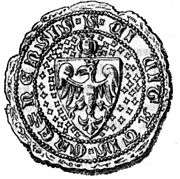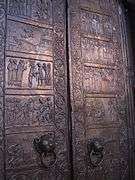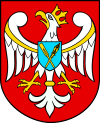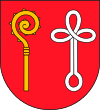Gniezno
| Gniezno | ||
|---|---|---|
| Royal Capital City of Gniezno Stołeczne Królewskie Miasto Gniezno | ||
 | ||
| ||
 Gniezno | ||
| Coordinates: 52°32′N 17°36′E / 52.533°N 17.600°E | ||
| Country |
| |
| Voivodeship | Greater Poland | |
| County | Gniezno County | |
| Gmina | Gniezno (urban gmina) | |
| Established | 8th-10th century | |
| Town rights | 1239 | |
| Government | ||
| • Mayor | Tomasz Budasz | |
| Area | ||
| • Total | 49 km2 (19 sq mi) | |
| Population (2006) | ||
| • Total | 70,080 | |
| • Density | 1,400/km2 (3,700/sq mi) | |
| Time zone | CET (UTC+1) | |
| • Summer (DST) | CEST (UTC+2) | |
| Postal code | 62–200 to 62–210 | |
| Area code(s) | +48 61 | |
| Car plates | PGN | |
| Climate | Dfb | |
| Website | http://www.Gniezno.eu | |

Gniezno ([ˈɡɲeznɔ]; German: Gnesen) is a city in central-western Poland, some 50 kilometres (31 miles) east of Poznań, with some 70,000 inhabitants. One of the Piast dynasty's chief cities, it was mentioned in 10th-century sources, including the Dagome Iudex, as the capital of Piast Poland. The Roman Catholic archbishop of Gniezno is the primate of Poland, making it the country's ecclesiastical capital. It has belonged since 1999 to the Greater Poland Voivodeship, and is the administrative seat of Gniezno County (powiat).
History
There are archaeological traces of human settlement since the late Paleolithic. Early Slavonic settlements on the Lech Hill and the Maiden Hill are dated to the 8th century.[1] At the beginning of the 10th century this was the site of several places sacred to the Slavic religion. The ducal stronghold was founded just before AD 940 on the Lech Hill, and surrounded with some fortified suburbs and open settlements.
Legend of Lech, Czech and Rus
According to the Polish version of legends, "Three brothers Lech, Czech and Rus were exploring the wilderness to find a place to settle. Suddenly they saw a hill with an old oak and an eagle on top. Lech said, 'This white eagle I will adopt as an emblem of my people, and around this oak I will build my stronghold, and because of the eagle nest [gniazdo in Polish][1] I will call it Gniezdno [modern: Gniezno].' The other brothers went further on to find a place for their people. Czech went to the South" (to found the Czech Lands) "and Rus went to the East" (to create the Rus' (region)).
Cradle of the Polish state
Around AD 940 Gniezno, being an important pagan cult center, became one of the main fortresses of the early Piast rulers, along with aforementioned fortresses at Giecz, Kruszwica, Poznań, Kalisz, Łęczyca, Ostrów Lednicki, Płock, Włocławek others. Mieszko I might have moved the capital to Gniezno from Poznań after his own and his realm's baptism, but actual move of the capital to Gniezno might have coincided with a growing German menace of the late 10th century and early 11th century depositing the remains of Saint Adalbert in a newly built church, to underline Gniezno's importance as the religious centre and capital of Bolesław I Chrobry's kingdom.
Congress of Gniezno
It is here that the Congress of Gniezno took place in the year 1000 AD, during which Bolesław I the Brave, Duke of Poland, received Holy Roman Emperor Otto III.[2] The emperor and the Polish duke celebrated the foundation of the Polish ecclesiastical province (archbishopric) in Gniezno, with newly established bishopric in Kołobrzeg for Pomerania; Wrocław for Silesia; Kraków for Lesser Poland and later also already existing since 968 bishopric in Poznań for western Greater Poland.
Royal coronation site
The 10th-century Gniezno cathedral witnessed royal coronations of Bolesław I in 1024 and his son Mieszko II Lambert in 1025.[1] The cities of Gniezno and nearby Poznań were captured, plundered and destroyed in 1038 by the Bohemian duke Bretislav I, which pushed the next Polish rulers to move the Polish capital to Kraków.[1] The archiepiscopal cathedral was reconstructed by the next ruler, Bolesław II the Generous, who was crowned king here in 1076.
In the next centuries Gniezno evolved as a regional seat of the eastern part of Greater Poland, and in 1238 municipal autonomy was granted by the duke Władysław Odonic. Gniezno was again the coronation site in 1295 and 1300.
Regional site of Greater Poland
The city was destroyed again by the Teutonic Knights' invasion in 1331, and after an administrative reform became a county within the Kalisz Voivodeship (since the 14th century till 1768). Gniezno was hit by heavy fires in 1515, 1613, was destroyed during the Swedish invasion wars of the 17th–18th centuries and by a plague in 1708–1710. All this caused depopulation and economic decline, but the city was soon revived during the 18th century to become the Gniezno Voivodeship in 1768.
Prussia
Gniezno was annexed by the Kingdom of Prussia in the 1793 Second Partition of Poland and became part of the province of South Prussia. During the Kościuszko Uprising Polish army under general Jan Henryk Dąbrowski liberated[3] the town on 22 August 1794 and defeated a Prussian Army north of Gniezno near Łabiszyn on 29 September 1794. But because of Kościuszko's defeat at the Battle of Maciejowice he gave up planning winter in Bydgoszcz and moved through Toruń and retreated to central Poland. Thus, the Prussians retook it on 7 December 1794. During the Napoleonic Wars an uprising against Prussian rule happened. French appeared in Gniezno in November 1806, and following general Jan Henryk Dabrowski's order issued to all towns and cities and country property owners to provide recruits for the organizing Polish forces, Gniezno initially provided 60 recruits who participated in the battles of 1806–07.[4] Consequently, the town was included within the Duchy of Warsaw, but upon defeat of Napoleon in Russian in 1812 was occupied by the Russian army and was returned to Prussia in the 1815 Congress of Vienna. Gniezno was subsequently governed within Kreis Gnesen of the Grand Duchy of Posen and the later Province of Posen. Following the Greater Poland Uprising (1918–1919) and the Treaty of Versailles Gniezno became part of the Second Polish Republic. Its citizen-soldiers joined the Polish army fighting the Bolsheviks during the Polish–Soviet War.[5]
World War II
Gniezno was occupied by German troops on 11 September 1939 and annexed into Nazi Germany on 26 October 1939 after the invasion of Poland and made part of Reichsgau Wartheland. The town was liberated by the Red Army on 21 January 1945 and restored to Poland.
Archbishops of Gniezno
Gniezno's Roman Catholic archbishop is traditionally the Primate of Poland (Prymas Polski). After the partitions of Poland the see was often combined with others, first with Poznań and then with Warsaw. In 1992 Pope John Paul II reorganized the Polish hierarchy and the city once again had a separate bishop. Cardinal Józef Glemp, who had been archbishop of Gniezno and Warsaw and retained Warsaw, was designated to remain Primate until his retirement, but afterward the Archbishop of Gniezno, at present Józef Kowalczyk, would again be Primate of Poland.
Royal coronations in Gniezno cathedral

- 25 December 1024 – Bolesław I the Brave
- 25 December 1025 – Mieszko II Lambert and his wife Richensa of Lotharingia
- 25 December 1076 – Bolesław the Generous and his wife Wyszesława of Kiev
- 26 June 1295 – Przemysł II and his wife Margaret of Brandenburg
- August 1300 – Wenceslaus II of Bohemia
| Year | Number of inhabitants |
|---|---|
| 1912 | 25 339 |
| 1980 | 62 400 |
| 1990 | 70 400 |
| 1995 | 71 000 |
People from Gniezno
- Hermann Senator (1834–1911), German physician
- Jacob Caro (1836–1904), German historian
- Ludwik Ćwikliński (1853–1942), Polish classical philologist
- Günther Pancke (1889–1973), German SS – General
- Heinz Reinefarth (1903–1979), German SS – General
- Alfons Flinik (1926–2003), Polish field hockey player
- Paweł Arndt (born 1954), Polish politician
- Arkadiusz Radomski (born 1977), Polish footballer
- Łukasz Cieślewicz (born 1987), Polish footballer
- Zo Nowak (born 1991), Polish Victoria's Secret model
- Kacper Gomólski (born 1993), Polish speedway rider
Education
- Collegium Europaeum Gnesnense (part of Adam Mickiewicz University in Poznań)
- The Gniezno School of Humanism and Management - Millennium (Gnieźnieńska Wyższa Szkoła Humanistyczno-Menedżerska Millennium)
- The Archbishop's Ecclesiastical Seminary (Prymasowskie Wyższe Seminarium Duchowne)
- The State Vocational College in Gniezno (Państwowa Wyższa Szkoła Zawodowa)
Arts and culture
- Aleksander Fredro Theatre (Teatr im. A. Fredry)
- Museum of the Polish State Origins (Muzeum Początków Państwa Polskiego)
- Museum of Archdiocese (Muzeum Archidiecezji Gnieźnieńskiej)
Twin towns — sister cities
 Anagni, Italy
Anagni, Italy Esztergom, Hungary
Esztergom, Hungary Falkenberg, Sweden
Falkenberg, Sweden Saint-Malo, France
Saint-Malo, France Sergiyev Posad, Russia
Sergiyev Posad, Russia Speyer, Germany
Speyer, Germany Radviliškis, Lithuania
Radviliškis, Lithuania Uman, Ukraine
Uman, Ukraine Veendam, Netherlands[7]
Veendam, Netherlands[7]
Gallery
|
See also
- Gniezno Cathedral
- History of Poland
- Adalbert of Prague
- Royal coronations in Gniezno cathedral
- Gniezno Doors
- Archdiocese of Gniezno
References
- 1 2 3 4 Neil Wilson; Tom Parkinson; Richard Watkins (2005). "Poland". Poland (Google Books). Lonely Planet. p. 339. ISBN 1-74059-522-X. Retrieved 26 December 2010. (English)
- ↑ Günther Stöckl: Die Geschichte der Slavenmission. In: Die Kirche in ihrer Geschichte – Ein Handbuch (edited by Bernd Moeller). 2nd edition, vol. 2, Göttingen 1976, ISBN 3-525-52318-1, p. 91 (in German, limited online preview)
- ↑ 25.9 wyzwolono Gniezno (on 25th 9 Gniezno was liberated) (English) Marian B. Michalik; Eugeniusz Duraczyński (1994). Kronika powstań polskich 1794–1944. "Kronika"-Marian B. Michalik. p. 44. ISBN 83-86079-02-9.
- ↑ (English) Marian B. Michalik; Eugeniusz Duraczyński (1891). Roczniki. Poznańskie Towarzystwo Przyjaciół Nauk (Poznań Society of Friends of Science). p. 44. ISBN 83-86079-02-9.
- ↑ (English) Marian Woźniak (1998). Encyklopedia konspiracji wielkopolskiej: 1939–1945 (Encyclopedia of conspiracy in Greater Poland: 1939–1945). Instytut Zachodni. ISBN 83-85003-97-5. multiple pages (individual biographies) e.g. p. 275
- ↑ "International collaboration". gmiezno.eu. Gniezno. Retrieved 3 May 2014.
- ↑ "Zustersteden". Veendam. Retrieved 3 May 2014.
External links
| Wikimedia Commons has media related to Gniezno. |
| Wikisource has several original texts related to: Gniezno |
 Gniezno travel guide from Wikivoyage
Gniezno travel guide from Wikivoyage- Gniezno homepage (English and German version also available), The official site of the Gniezno City's Administration, from which much of the above was taken and adapted.
- Gniezno Poviat The official site of the Gniezno County, (English, German, Spanish, French, Italian and Russian version also available)
Coordinates: 52°33′N 17°36′E / 52.550°N 17.600°E




